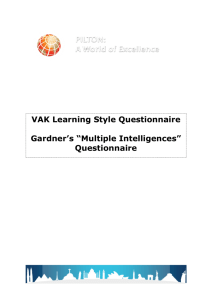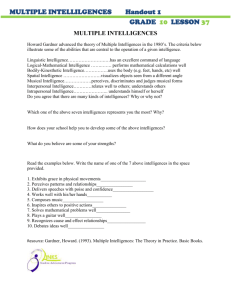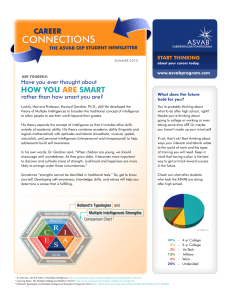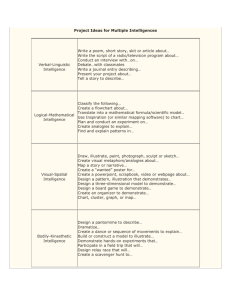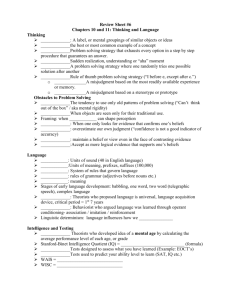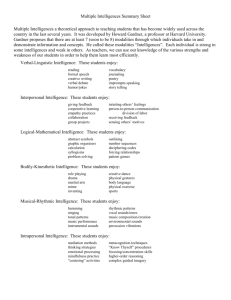Multiple Intelligences descriptions
advertisement
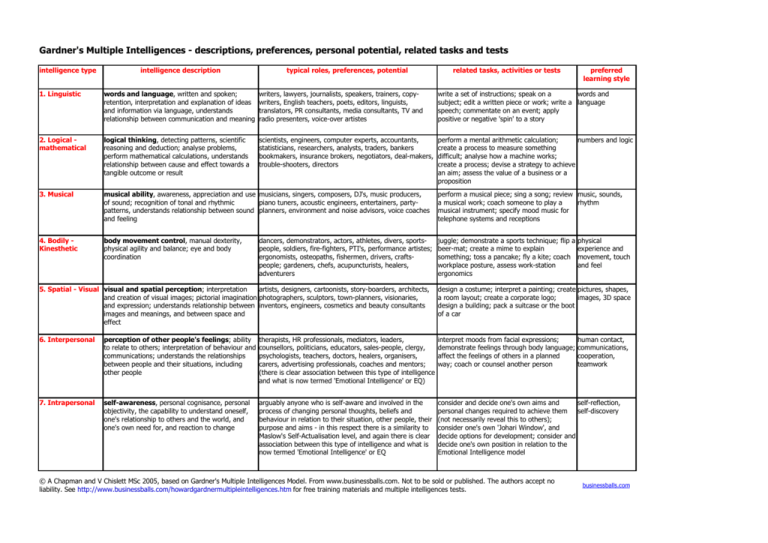
Gardner's Multiple Intelligences - descriptions, preferences, personal potential, related tasks and tests intelligence type intelligence description typical roles, preferences, potential related tasks, activities or tests preferred learning style 1. Linguistic words and language, written and spoken; retention, interpretation and explanation of ideas and information via language, understands relationship between communication and meaning writers, lawyers, journalists, speakers, trainers, copywriters, English teachers, poets, editors, linguists, translators, PR consultants, media consultants, TV and radio presenters, voice-over artistes write a set of instructions; speak on a words and subject; edit a written piece or work; write a language speech; commentate on an event; apply positive or negative 'spin' to a story 2. Logical mathematical logical thinking, detecting patterns, scientific reasoning and deduction; analyse problems, perform mathematical calculations, understands relationship between cause and effect towards a tangible outcome or result scientists, engineers, computer experts, accountants, statisticians, researchers, analysts, traders, bankers bookmakers, insurance brokers, negotiators, deal-makers, trouble-shooters, directors perform a mental arithmetic calculation; numbers and logic create a process to measure something difficult; analyse how a machine works; create a process; devise a strategy to achieve an aim; assess the value of a business or a proposition 3. Musical musical ability, awareness, appreciation and use musicians, singers, composers, DJ's, music producers, of sound; recognition of tonal and rhythmic piano tuners, acoustic engineers, entertainers, partypatterns, understands relationship between sound planners, environment and noise advisors, voice coaches and feeling perform a musical piece; sing a song; review music, sounds, a musical work; coach someone to play a rhythm musical instrument; specify mood music for telephone systems and receptions 4. Bodily Kinesthetic body movement control, manual dexterity, physical agility and balance; eye and body coordination juggle; demonstrate a sports technique; flip a beer-mat; create a mime to explain something; toss a pancake; fly a kite; coach workplace posture, assess work-station ergonomics dancers, demonstrators, actors, athletes, divers, sportspeople, soldiers, fire-fighters, PTI's, performance artistes; ergonomists, osteopaths, fishermen, drivers, craftspeople; gardeners, chefs, acupuncturists, healers, adventurers physical experience and movement, touch and feel 5. Spatial - Visual visual and spatial perception; interpretation artists, designers, cartoonists, story-boarders, architects, and creation of visual images; pictorial imagination photographers, sculptors, town-planners, visionaries, and expression; understands relationship between inventors, engineers, cosmetics and beauty consultants images and meanings, and between space and effect design a costume; interpret a painting; create pictures, shapes, a room layout; create a corporate logo; images, 3D space design a building; pack a suitcase or the boot of a car 6. Interpersonal perception of other people's feelings; ability to relate to others; interpretation of behaviour and communications; understands the relationships between people and their situations, including other people therapists, HR professionals, mediators, leaders, counsellors, politicians, educators, sales-people, clergy, psychologists, teachers, doctors, healers, organisers, carers, advertising professionals, coaches and mentors; (there is clear association between this type of intelligence and what is now termed 'Emotional Intelligence' or EQ) interpret moods from facial expressions; demonstrate feelings through body language; affect the feelings of others in a planned way; coach or counsel another person 7. Intrapersonal self-awareness, personal cognisance, personal objectivity, the capability to understand oneself, one's relationship to others and the world, and one's own need for, and reaction to change arguably anyone who is self-aware and involved in the process of changing personal thoughts, beliefs and behaviour in relation to their situation, other people, their purpose and aims - in this respect there is a similarity to Maslow's Self-Actualisation level, and again there is clear association between this type of intelligence and what is now termed 'Emotional Intelligence' or EQ consider and decide one's own aims and self-reflection, personal changes required to achieve them self-discovery (not necessarily reveal this to others); consider one's own 'Johari Window', and decide options for development; consider and decide one's own position in relation to the Emotional Intelligence model © A Chapman and V Chislett MSc 2005, based on Gardner's Multiple Intelligences Model. From www.businessballs.com. Not to be sold or published. The authors accept no liability. See http://www.businessballs.com/howardgardnermultipleintelligences.htm for free training materials and multiple intelligences tests. human contact, communications, cooperation, teamwork businessballs.com
